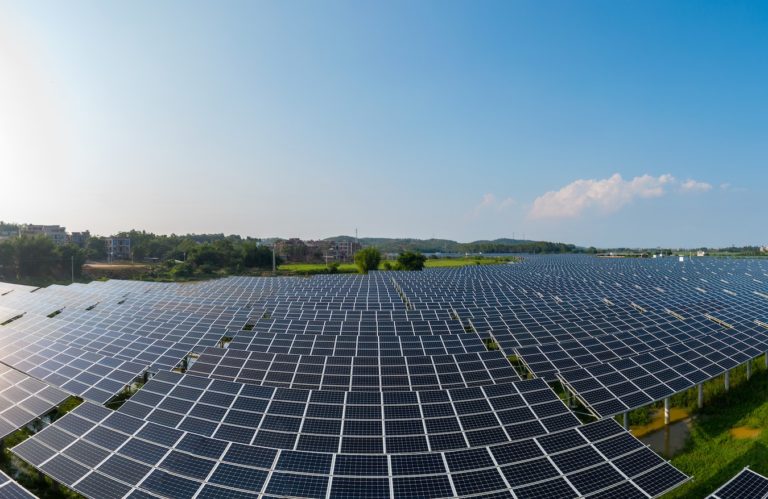What comes to mind when you think of energy in the United States? Most people probably picture a texas oil field, an oil pipeline, or some other incarnation of the fossil fuel that’s been driving the world since the 1800s.
However, as our country seeks new ways to gain energy independence, oil has started to take a backseat to green energy sources. While most people may be familiar with solar panels, wind turbines, and hydroelectric dams, they may be surprised to find that the natural resource most critical for creating sustainable energy is silver.
In this article, we’ll discuss what silver is used for in the drive for energy independence, how it’s being used in various green technologies and products, and why we believe silver is one of the best long-term investments available.
What Is Energy Independence?
Energy independence refers to the ability to produce enough energy to meet personal demands without relying on others. On the national level, energy independence means a country’s ability to use its own resources to sustain itself rather than importing resources from other nations. Countries that can’t support themselves tend to have less power in international politics.
The U.S. government used to rely on oil imports from countries like Venezuela and Saudi Arabia, but it began to shift focus to energy independence after the oil embargo of 1973.
While we still may buy oil from Saudi Arabia, our country buys oil from a number of other nations as well that use their resources to produce massive amounts of gasoline at lower costs. Because of this, our economy is more vulnerable than ever and could face significant crises when world leaders like Iran or Russia turn off their taps to exert some political leverage over us through market manipulation.
For almost 200 years, oil has been the highest-prized international commodity. Nations that can produce it faster, cheaper, and in greater supply typically have more control of the world’s economic situation and reliant countries. Energy independence evens the playing field.
Oil in America’s History
Oil has been integral to American life for more than a century. Its role in the American economy, culture, and politics has been significant and growing larger as demands increase. Oil is the cornerstone of our nation’s military, finances, and government, becoming a key component of America’s identity ever since its discovery.
In the 1840s, a Pennsylvania salt miner named Samuel Keir discovered some substance was contaminating his salt deposits. He realized the root cause was oil and set the stage for numerous attempts over the years to collect and break up the oil. In 1854, George Bissell succeeded in distilling a portion of the oil into kerosene.
About a year later, Bissell established the Pennsylvania Rock Oil Company and became the first person to industrialize oil drilling in America. He drilled on sites around the Titusville, PA, area and struck oil on August 27, 1859. The famous location earned the nickname Oil Creek, and George Bissell etched his name forever in U.S. history as the father of the American oil industry.
Oil production and usage have infinitely expanded since 1859. Today, petroleum products are crucial in many areas, including:
- Military: As mighty as the U.S. military is, it wouldn’t exist without oil. Millions of oil barrels go toward powering ships, aircraft, and vehicles. Without oil, most of our military operations wouldn’t be possible.
- Economy: People use cars, trucks, SUVs, buses, trains, and many other vehicles every day to get from one place to the next and to transport goods. They also use tons of electricity and heating during the winter months. Without oil, these facets of everyday life would fall apart and lead to economic depression.
- Government: Oil is an international currency, giving countries bargaining power in the game of global politics. The U.S. government has bought and traded oil for a long time to help it stay on top as a world leader.
Since the days of George Bissell, oil has become the heart and soul of America. The U.S. military, economy, and government (just to name a few areas) all rely heavily on petroleum to function correctly and effectively. Without this energy supply, we would never have thrived over the past 150-plus years.
Oil’s Concerning Influence on Global Warming
Global warming has become a looming concern for many world leaders, and many factors contribute to this crisis. One of the most significant contributing factors is oil production. Non-renewable energy sources like oil present a danger both physically and environmentally.
A primary culprit in global warming is carbon dioxide, which gets released by burning fossil fuels like oil. The more oil we burn, the more CO2 we release into the atmosphere, and the more we accelerate global climate change. Along with coal and other hydrocarbon emissions, environmental researchers have found that oil is mainly responsible for global warming.
Our society uses oil for almost everything: heating our homes, making plastics and chemicals, powering cars and trucks, heating water for showers and dishwashing, powering factories that make clothing and electricity, etc. The list goes on, but so does the problem of pollution. This is one main reason the United States is pushing for energy independence and eco-friendly solutions.
Energy Independence and Security Act
As the concern about global warming increases, so does the urgency to reduce carbon dioxide emissions from oil production. Using sustainable, clean energy is an excellent alternative to help preserve the environment. It’s also the solution to lowering energy prices as the fossil fuels supply can’t adequately keep up with soaring demands.
Relying on foreign sources for oil is also a significant concern. As the U.S. seeks to reduce dependency on other nations, it’s turned its attention toward energy independence. Global warming and oil dependency are what led to the Energy Independence and Security Act.
The Energy Independence and Security Act (EISA) is a law that President George W. Bush signed into effect in December 2007. The bill aims to decrease U.S. dependence on foreign oil and make America less vulnerable to supply shocks from regions like Venezuela, the Middle East, and Nigeria. The law does this by incentivizing alternatives to petroleum-based energy sources such as wind power, solar energy, and biofuels like ethanol or biodiesel.
Under the EISA, the United States is working toward a more self-sufficient, eco-friendly, safe future. The act gave the OK to incentives such as the following:
- Developing electric motor vehicles
- Advancing battery loan guarantees
- Improving manufacturing technologies for vehicles
- Implementing carbon credit schemes
- Developing biodiesel
- Researching natural gas and algal biomass
- Improving standards for lighting and appliances to increase energy savings
- Accelerating designs and development for solar energy, energy storage, photovoltaic cells, and hydrothermal and maritime research
EISA was the spark that forever changed the landscape of energy production and usage in the U.S. Solar energy, electric cars, wind farms, and other green energy solutions are the first stepping stones in America’s drive to energy independence.
Silver to the Energy Independence Rescue
As the U.S. continues to implement its Energy Independence and Security Act, it increasingly pushes oil out of the picture. To support green initiatives, alternative energy industries like wind, solar, and electric cars have received large subsidies to help advance the technology.
While each of these technologies uses a different approach to generate energy, one thing they all have in common is that they all have a number of key components that must be made from silver.
Silver conducts electricity better than any other element, allowing the renewable energy source to be as efficient and effective as possible. Silver is also cheaper than many other materials, making it the ideal alternative to oil as an energy source.
Nevada has one of the largest silver mines in the world: the Hycroft mine, which renders 1.82 million ounces of silver annually. With over 20 other silver mines in the state, collecting silver for energy independence incentives isn’t complicated. It’s no wonder Nevada is also known as The Silver State.
While the U.S. hasn’t been able to find energy independence through oil, it has been successful through silver. Our country has enough silver to sustain domestic needs without relying on foreign supplies. This self-sufficiency means that America can operate at the highest level while maintaining security.
Silver and Solar Energy
Solar energy has grown increasingly popular since the EISA passed in 2007. This form of renewable energy relies on sunlight to produce electricity, which powers almost every facet of our daily lives. Solar panels consist of photovoltaic cells that capture powerful rays from the sun and convert them into electricity.
Solar panels are a specific (and probably the most common form) of solar energy that can benefit America in a couple of different ways:
- Reducing the carbon footprint
- Increasing energy independence
For solar panels to work at maximum efficiency, they require silver. Engineers manufacture these photovoltaic cells using a layer of silver nanoparticles—an extremely small amount of silver that increases their ability to absorb energy.
Engineers have also utilized silver in other green energy equipment like wind turbines and fuel cell batteries. These technologies are still in their infancy but, if perfected, could provide power without polluting our air or water. Besides producing the electricity we need, this can help keep our environment safe for generations to come.
Silver lies at the core of solar energy. Without it, eco-friendly machines and energy independence are only a fantasy. As the United States moves toward being 100% self-sustaining, it will rely more and more heavily on silver.
How Investors Will Come Out on Top Because of Solar
What does America’s push away from fossil fuels toward solar energy mean for the silver market? It means the demand for silver will continue to increase, thereby increasing its potential value. This trend spells good tidings for precious metal investors.
The Energy Independence and Security Act of 2007 signaled a commitment for the U.S. to reduce oil production and increase silver production. In the same way that oil tycoons achieved their status by investing in the oil industry early on, investors could become silver tycoons by investing in the silver industry now. As popular as silver is now, it will likely be an even more coveted commodity in the future as technology continues to advance.
Solar energy is the future of daily life and business operations in the United States. This push for renewable energy production means an increase in silver production, which means the time for investors to act is now. Beyond solar energy, there are many other reasons to invest in silver today:
- Rising demand for consumer electronics: Amid the coronavirus pandemic, many people had to switch to remote work using a smartphone, desktop, and other devices. We’re now seeing unprecedented remote employment opportunities, all of which require up-to-date electronic devices built with silver components.
- Developing 5G technologies: Solar energy isn’t the only reason investing in silver is an excellent idea. Silver is also a critical piece of 5G technology. As these technologies continue to develop and improve, so will the demand for silver.
- Hedging against inflation: Inflation has been a significant concern for many businesspeople in the U.S. As the dollar value continues to plummet, paper currency won’t be as valuable as currencies like precious metals. You can invest in silver to seek protection against economic crises.
- Protecting yourself against geopolitical unrest: Recent conflicts involving Russia, China, and other world powers have caused gas prices in the U.S. to skyrocket and oil premiums to fluctuate. However, geopolitical unrest doesn’t have nearly as large an impact on the silver market. You can invest in silver and not worry about world events affecting your wealth.
- Finding an alternative to the stock market: The stock market can be volatile, leaving many people scratching their heads. However, the precious metals market is a much more stable investment option.
Take Advantage of the Silver Boom By Opening A Silver IRA
There has never been a better time to invest in silver. The role of silver in energy independence continues to increase, which means this precious metal will become even more valuable in the future. You can buy silver at a low spot price now and enjoy financial security and greater wealth down the road.
One of the best ways you can invest in silver and save for retirement at the same time is by opening a silver IRA with Noble Gold Investments. We offer a wide range of IRS-approved silver products, as well as gold, platinum, and palladium products, all of which can be purchased in a tax-advantaged IRA.
If you’re interested in learning more about opening a precious metals IRA, call us today at (877) 646-5347 to speak with a member of our team. We’d be happy to talk you through how a silver IRA works and can even help you get your account created.







